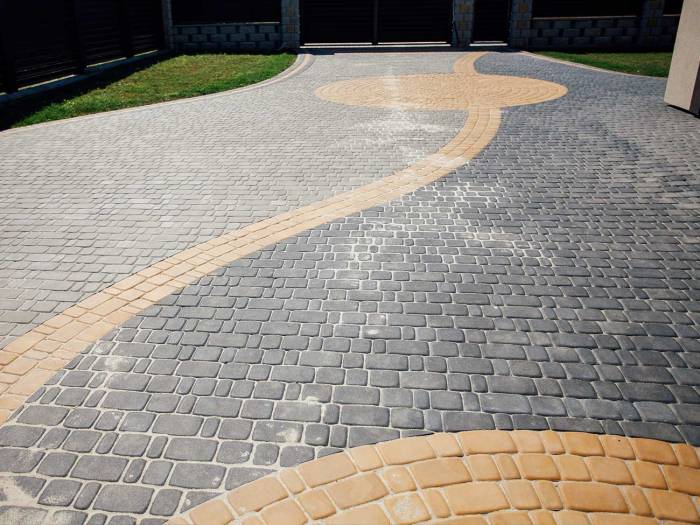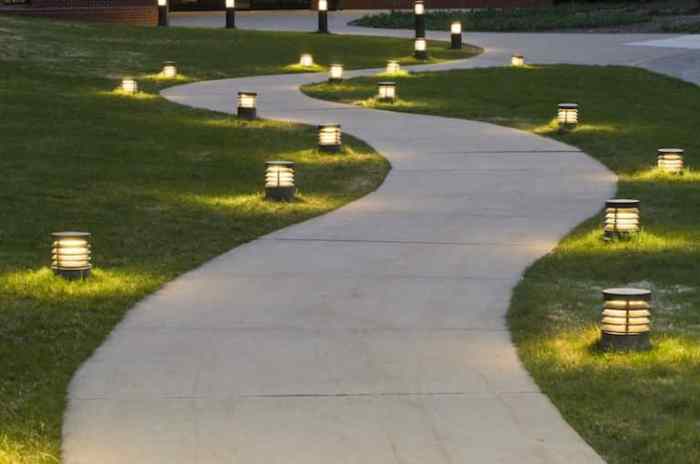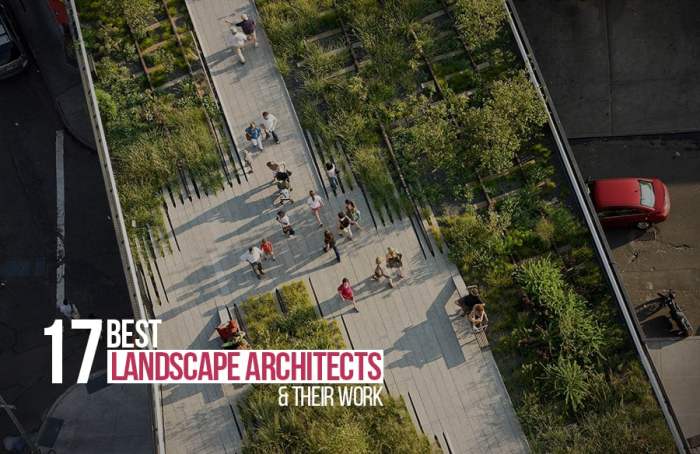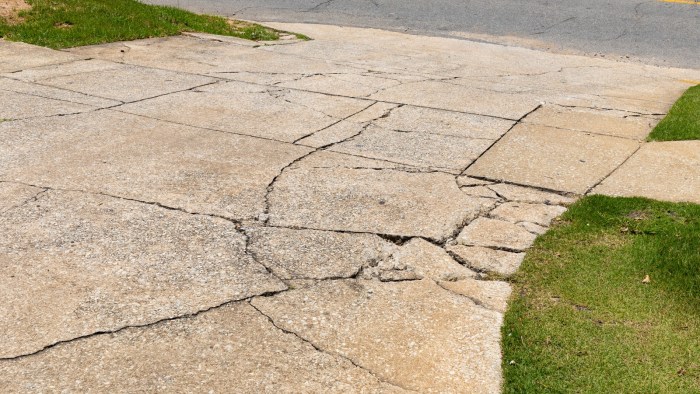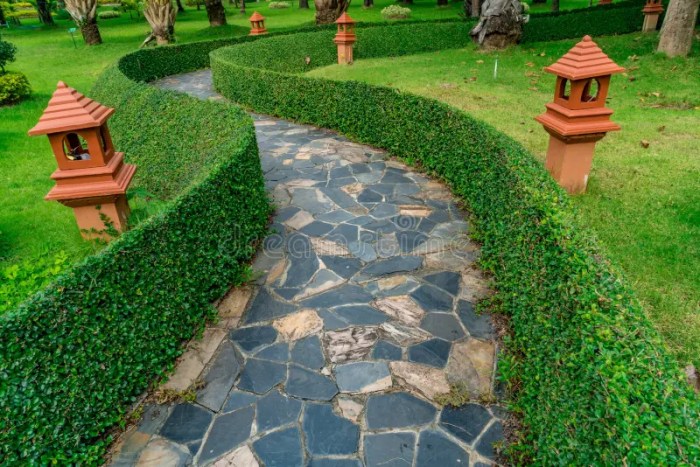Driveway Pathway Design, Materials & Cost
Driveway pathway design is more than just a functional entrance; it’s a key element shaping your home’s curb appeal and overall aesthetic. This guide dives into everything you need to know, from choosing the right materials like asphalt, concrete, pavers, or gravel, to crafting a design that complements your home’s style and enhances your property value. We’ll cover installation, maintenance, budgeting, and even safety considerations to ensure your driveway pathway is both beautiful and practical.
We’ll explore various design styles, from modern minimalism to rustic charm, and offer practical tips for integrating your pathway seamlessly into your landscaping. Learn how to choose materials that withstand the elements, manage drainage effectively, and create a welcoming and safe entrance for everyone. Whether you’re starting from scratch or renovating, this guide provides a comprehensive roadmap to building the perfect driveway pathway.
Driveway Pathway Materials
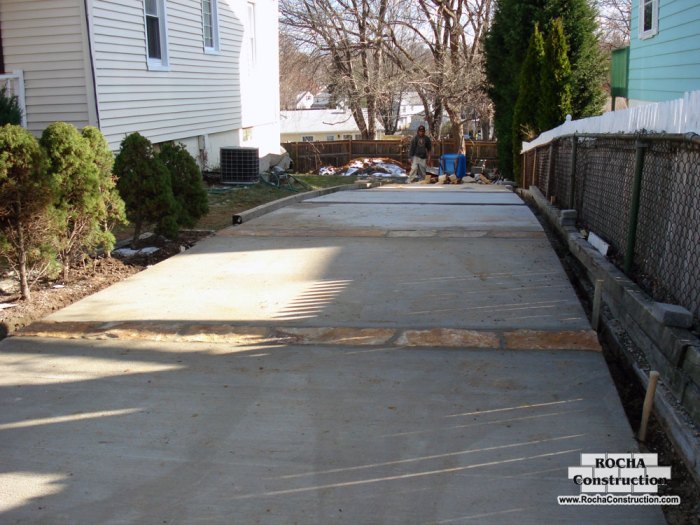
Source: rochaconstruction.com
Choosing the right material for your driveway pathway is a crucial decision that impacts both aesthetics and longevity. This section compares common materials, detailing installation and maintenance to help you make an informed choice. Consider factors like your budget, desired look, and the climate in your area.
Driveway Pathway Material Comparison
The table below summarizes the key characteristics of common driveway pathway materials. Remember that actual costs and lifespans can vary based on location, quality of materials, and installation expertise.
| Material | Durability | Cost (Approximate) | Aesthetic Appeal |
|---|---|---|---|
| Asphalt | Moderate; susceptible to cracking and potholes over time, especially in freeze-thaw climates. | Low to Moderate | Smooth, dark surface; can be customized with sealants for color. |
| Concrete | High; very durable and resistant to most weather conditions. | Moderate to High | Clean, versatile; can be stamped, stained, or textured for varied looks. |
| Pavers (Brick, Stone, etc.) | High; individual pavers can be replaced if damaged, offering easy repair. | High | Highly versatile; wide range of colors, shapes, and materials available for unique designs. |
| Gravel | Low; requires regular maintenance and can shift or wash away. | Low | Natural, rustic look; permeable, allowing water drainage. |
Asphalt Driveway Installation
Proper installation is vital for a long-lasting asphalt driveway. Here’s a general Artikel:
- Site Preparation: Excavate the area to the required depth, compact the base thoroughly, and add a gravel base for drainage.
- Asphalt Laying: Spread the hot asphalt evenly using a paving machine or by hand for smaller areas. Ensure proper thickness and compaction.
- Finishing: Smooth the surface with rakes and rollers to create a level, even finish.
- Curing: Allow the asphalt to cool and cure completely before driving on it.
Concrete Driveway Installation
Concrete driveways offer durability but require careful execution.
- Formwork: Construct forms to define the driveway’s dimensions and shape.
- Base Preparation: Prepare a compacted gravel base, ensuring proper drainage.
- Pouring Concrete: Pour the concrete into the forms, ensuring even distribution and thickness.
- Finishing: Use tools to smooth, level, and finish the surface, potentially adding textures or stamps.
- Curing: Proper curing is crucial to prevent cracking; keep the concrete moist for several days.
Paver Driveway Installation
Paver driveways offer flexibility and repairability.
- Base Preparation: Create a well-compacted base of gravel and sand for proper drainage and support.
- Edging: Install edging to contain the pavers and prevent shifting.
- Paver Laying: Lay the pavers according to your chosen pattern, ensuring even spacing and levelness.
- Compaction: Compact the pavers using a plate compactor to ensure stability.
- Sand Filling: Fill the joints between pavers with sand to stabilize and prevent weeds.
Gravel Driveway Installation
Gravel driveways are a cost-effective option but need consistent maintenance.
- Site Preparation: Excavate the area to the desired depth and shape.
- Weed Control: Apply a weed barrier fabric to prevent weed growth.
- Gravel Spreading: Spread the gravel evenly across the area.
- Compaction: Lightly compact the gravel to ensure stability.
Driveway Pathway Maintenance
Maintaining your driveway ensures its longevity and aesthetic appeal. Regular cleaning, timely repairs, and an understanding of the material’s lifespan are crucial.
- Asphalt: Requires sealing every few years to prevent cracking and water damage. Regular sweeping and occasional power washing are needed. Lifespan: 15-20 years.
- Concrete: Relatively low maintenance; occasional cleaning and sealing to prevent staining. Repairing cracks is important to prevent further damage. Lifespan: 25-50 years.
- Pavers: Regular sweeping and occasional power washing to remove dirt and debris. Individual pavers can be replaced if damaged. Lifespan: 25-50+ years depending on material.
- Gravel: Requires regular replenishment as gravel shifts and washes away. Weed control is also necessary. Lifespan: Varies greatly depending on maintenance, but can be shorter than other options.
Driveway Pathway Design
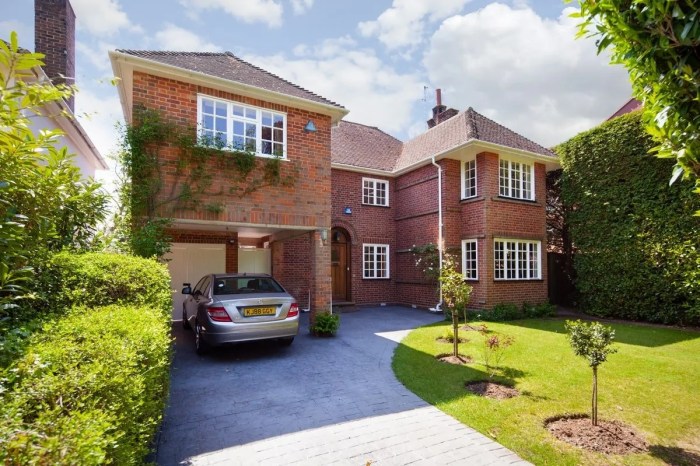
Source: co.uk
Designing your driveway pathway is more than just choosing a material; it’s about creating a welcoming entrance that complements your home’s style and enhances its curb appeal. A well-designed pathway can significantly increase your property’s value and make a lasting impression on visitors. Consider your home’s architectural style, the surrounding landscape, and your personal preferences when making your design choices.
Driveway Pathway Designs for Different House Styles
This section details three distinct driveway pathway designs, each tailored to a specific architectural style: modern, traditional, and rustic. These examples illustrate how material choices and landscaping can dramatically alter the overall aesthetic.
- Modern Driveway: This design features a clean, minimalist aesthetic. Imagine a wide, straight pathway (approximately 12 feet wide and 40 feet long) made of smooth, light grey concrete. The concrete is poured with a subtle texture, avoiding overly ornate patterns. Landscaping is minimal, consisting of strategically placed, low-growing succulents and grasses in sleek, modern planters. The color palette is limited to cool grays, whites, and greens, maintaining a sense of calm and sophistication. The overall impression is one of sleek simplicity and understated elegance.
- Traditional Driveway: This design embraces classic elegance. Picture a gently curving pathway (approximately 10 feet wide and 50 feet long) constructed from interlocking pavers in a rich, warm reddish-brown hue. The pavers create a subtly textured surface. Mature, well-manicured shrubs flank the pathway, providing a sense of established beauty. The color palette includes deep reds, browns, and greens, creating a feeling of warmth and timeless charm. This design incorporates a classic border of low-growing boxwood hedges. The overall aesthetic is one of established sophistication and refined charm.
- Rustic Driveway: This design emphasizes natural materials and a relaxed feel. Envision a wider, more irregularly shaped pathway (approximately 15 feet wide and 60 feet long) made from natural flagstone in varying shades of grey and brown. The flagstones are laid in a somewhat haphazard, yet intentional, pattern, creating a rustic, uneven texture. The landscaping integrates wildflowers, native grasses, and perhaps a small stone retaining wall. The color palette is earthy and muted, emphasizing natural tones. The overall feel is one of relaxed elegance and connection to nature. A weathered wooden gate could add to the rustic charm.
Visual Descriptions of Driveway Pathway Designs
The visual impact of a driveway pathway is crucial. Consider the interplay of color, texture, and overall aesthetic. The following descriptions further elaborate on the visual aspects of each design.
- Modern Driveway: The visual effect is one of clean lines and subtle textures. The light grey concrete provides a neutral backdrop, allowing the minimalist landscaping to stand out. The overall feeling is one of modern sophistication and understated elegance. The lack of strong color contrasts contributes to the calm, serene atmosphere.
- Traditional Driveway: The warm reddish-brown pavers create a welcoming and inviting entrance. The carefully manicured shrubs add a touch of formality, while the subtle curves of the pathway soften the overall effect. The color palette creates a sense of warmth and timeless elegance. The combination of color and texture suggests a well-established and cared-for property.
- Rustic Driveway: The natural flagstones create a visually interesting and texturally rich surface. The varied shades of grey and brown add depth and character. The wildflower and grass landscaping creates a sense of natural beauty and relaxed charm. The overall visual effect is one of natural elegance and rustic charm.
Impact of Driveway Pathway Design on Curb Appeal and Property Value
A well-designed driveway pathway significantly impacts curb appeal and property value. A visually appealing entrance creates a positive first impression, increasing the perceived value of the property. For example, a thoughtfully landscaped driveway with high-quality materials can add thousands of dollars to a home’s resale value, especially in competitive markets. Conversely, a neglected or poorly designed driveway can detract from the overall appearance and diminish the property’s value. Studies have shown a direct correlation between landscaping improvements, including driveway upgrades, and increased property values.
Driveway Pathway Functionality & Safety
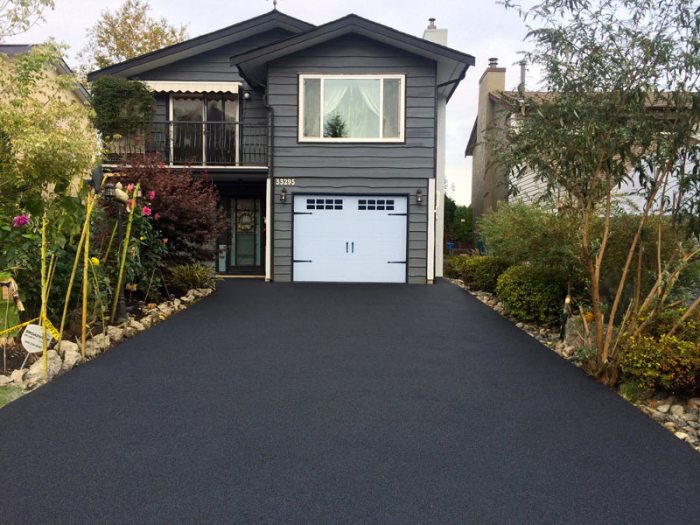
Source: smartconsumerinsider.com
A functional and safe driveway pathway is crucial for both the usability and safety of your property. Careful consideration of potential hazards and the needs of all users, including those with mobility limitations, is essential during the design and construction phases. This section will address key aspects of ensuring your driveway pathway is both practical and safe.
Potential Safety Hazards and Mitigation Strategies
Addressing potential safety hazards is paramount for a safe driveway pathway. Failing to do so can lead to accidents and injuries. The following points highlight common hazards and effective mitigation strategies.
- Hazard: Uneven surfaces and tripping hazards. Solution: Ensure a smooth, level surface throughout the pathway. Use materials that resist cracking and settling, and regularly inspect and repair any damage. Consider adding textured surfaces for better grip in wet conditions.
- Hazard: Poor lighting at night. Solution: Install adequate pathway lighting, such as solar-powered lights or low-voltage landscape lighting. Ensure lights are positioned to illuminate the entire pathway without creating glare.
- Hazard: Slippery surfaces, especially in wet or icy conditions. Solution: Choose non-slip materials for the pathway surface. Consider adding textured surfaces or anti-slip treatments. Regularly clear snow and ice during winter months.
- Hazard: Obstructions on the pathway. Solution: Keep the pathway free of debris, such as leaves, branches, and toys. Ensure adequate clearance around any fixed elements, such as mailboxes or landscaping.
- Hazard: Steep inclines or declines. Solution: Design the pathway with gentle slopes to avoid steep inclines or declines that could be difficult to navigate, particularly for individuals with mobility limitations. Consider ramps or other accessibility features for significant elevation changes.
Accessible Driveway Pathway Designs
Designing an accessible driveway pathway ensures that individuals with mobility limitations can safely and easily access your property. Consider the following design features to enhance accessibility:
- Wide Pathways: A minimum width of 36 inches is recommended to allow for wheelchair or mobility scooter access. Wider pathways provide more space for maneuvering and passing.
- Gentle Slopes: Steep inclines should be avoided. The maximum slope should be no more than 1:12 (or 8.33%), and ideally even gentler for longer stretches. Ramps with appropriate landings should be incorporated for significant elevation changes.
- Level Landings: Level landings are essential at the top and bottom of ramps and any changes in direction. These provide resting points and allow for safe maneuvering.
- Non-Slip Surfaces: Choose materials that offer good traction, even in wet or icy conditions. Textured surfaces are beneficial.
- Clear Signage: If there are any changes in elevation or direction, clear and visible signage can aid navigation.
Best Practices for Drainage and Water Damage Prevention, Driveway pathway
Proper drainage is crucial to prevent water damage to your driveway pathway and surrounding areas. Neglecting drainage can lead to erosion, cracking, and other issues. The following best practices should be implemented:
- Grading: Ensure the pathway is graded to slope slightly away from the house and any structures, directing water away from the foundation and preventing pooling.
- Drainage Systems: Install drainage systems, such as French drains or gravel trenches, to collect and divert excess water away from the pathway. This is particularly important in areas with heavy rainfall or poor soil drainage.
- Permeable Paving Materials: Consider using permeable paving materials, such as porous concrete or gravel, which allow water to seep through, reducing surface runoff and minimizing the risk of water damage.
- Gutter Systems: Ensure that gutters and downspouts are properly functioning and direct water away from the pathway and foundation. Extend downspouts with extensions to carry water further away.
- Regular Maintenance: Regularly inspect the pathway for any signs of damage or drainage issues. Clear debris and leaves from drains and gutters to ensure proper water flow.
Driveway Pathway and Landscaping Integration

Source: inksoft.com
Seamlessly blending your driveway pathway with the surrounding landscape enhances the overall aesthetic appeal of your property and creates a cohesive outdoor space. Careful consideration of materials, plants, and hardscaping elements is crucial for achieving a natural and visually pleasing integration. Ignoring this aspect can result in a jarring contrast between the pathway and the rest of your yard.
Integrating your driveway pathway into your landscape design involves more than just choosing pretty plants. It’s about creating a unified visual flow that complements the style of your home and enhances the functionality of your outdoor space. The right choices can dramatically improve curb appeal and property value.
Plant Selection for Driveway Pathway Integration
The choice of plants significantly impacts the overall look and feel of your driveway pathway. Consider factors such as sun exposure, soil type, and the pathway material when selecting plants. Low-maintenance options are ideal for busy lifestyles. For example, drought-tolerant native plants are perfect for gravel driveways in arid climates, minimizing water usage and promoting biodiversity.
Hardscaping Elements and Driveway Pathway Materials
Hardscaping, which includes elements like retaining walls, stepping stones, and borders, can create a beautiful transition between the driveway and the surrounding landscape. For instance, a natural stone retaining wall can elegantly frame a gravel driveway, while strategically placed stepping stones can lead from the pathway to other areas of the garden. The material of your driveway pathway directly influences the hardscaping choices. A concrete driveway might pair well with clean-lined brick borders, while a permeable paver pathway might look best with a more rustic, natural stone edging.
Landscape Design Example: Gravel Pathway with Native Plantings
Imagine a gravel driveway winding through a garden featuring native wildflowers and drought-tolerant grasses. The gravel’s natural texture complements the organic forms of the plants. Low-growing sedums and coneflowers, interspersed with taller grasses like little bluestem, create a dynamic and colorful border that softens the hard lines of the gravel. A few strategically placed boulders add visual interest and anchor the planting beds. This design not only enhances the aesthetic appeal but also requires minimal maintenance and promotes biodiversity, reducing the need for excessive watering and chemical treatments. This approach is particularly effective in areas with limited water resources. The visual effect is one of natural elegance, where the driveway becomes an integral part of the landscape rather than a separate element.
Driveway Pathway Cost & Budgeting

Source: kuert.com
Planning a new driveway pathway involves more than just choosing pretty stones; it requires a realistic budget. Understanding the costs involved upfront helps avoid unpleasant surprises and ensures a smooth project. This section breaks down the typical expenses and offers tips for managing your budget effectively.
The total cost of a driveway pathway project is highly variable, depending on factors like the pathway’s size, the materials selected, the complexity of the design, and your location. Labor costs can also fluctuate based on regional rates and the contractor’s experience.
Typical Cost Breakdown
The following table provides a general estimate of the costs associated with a typical driveway pathway project. Remember that these are averages and your actual costs may vary. It’s always best to get multiple quotes from reputable contractors in your area.
| Cost Category | Low Estimate | Average Estimate | High Estimate |
|---|---|---|---|
| Materials (pavers, gravel, concrete, etc.) | $500 – $1,000 | $1,500 – $3,000 | $4,000 – $8,000+ |
| Labor (excavation, installation, finishing) | $1,000 – $2,000 | $2,500 – $5,000 | $6,000 – $12,000+ |
| Permits and Inspections | $100 – $300 | $300 – $500 | $500 – $1,000+ |
| Contingency (for unexpected expenses) | $200 – $400 | $500 – $1,000 | $1,000 – $2,000+ |
| Total Estimated Cost | $1,800 – $3,700 | $4,800 – $9,500 | $11,500 – $23,000+ |
Tips for Staying Within Budget
Successfully managing your driveway pathway budget requires careful planning and proactive measures. Here are some key strategies to consider.
Consider using less expensive materials, such as gravel or recycled materials, for portions of the pathway where high durability isn’t critical. For example, a less trafficked side path might use gravel, while the main driveway uses more durable pavers. Opting for a simpler design can also significantly reduce labor costs. Finally, thoroughly research and compare quotes from multiple contractors to ensure you’re getting the best price for the quality of work you need.
Financing Options
Several financing options can make a driveway pathway project more manageable. Exploring these avenues can allow you to spread the cost over time.
Many homeowners utilize home equity loans or lines of credit (HELOCs) to finance home improvement projects like driveways. These loans use your home’s equity as collateral. Alternatively, some contractors offer financing plans, allowing you to pay for the project in installments. Finally, consider using a personal loan or credit card, but be mindful of interest rates and repayment terms. It is crucial to compare interest rates and terms from different lenders before committing to any financing option.
Final Summary
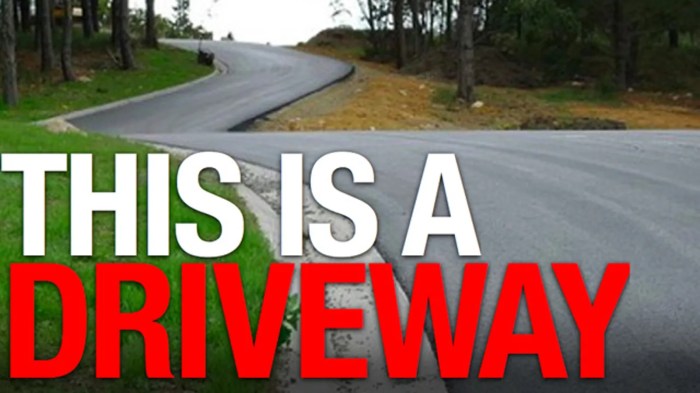
Source: kinja-img.com
Creating the ideal driveway pathway involves careful consideration of design, materials, budget, and safety. By thoughtfully weighing the pros and cons of different materials, integrating your pathway with the surrounding landscape, and addressing potential safety hazards, you can transform your entrance into a stunning and functional feature that enhances your property’s value and curb appeal. Remember to plan your budget carefully, explore different financing options if needed, and enjoy the process of creating a driveway pathway that reflects your style and enhances your home’s beauty.

